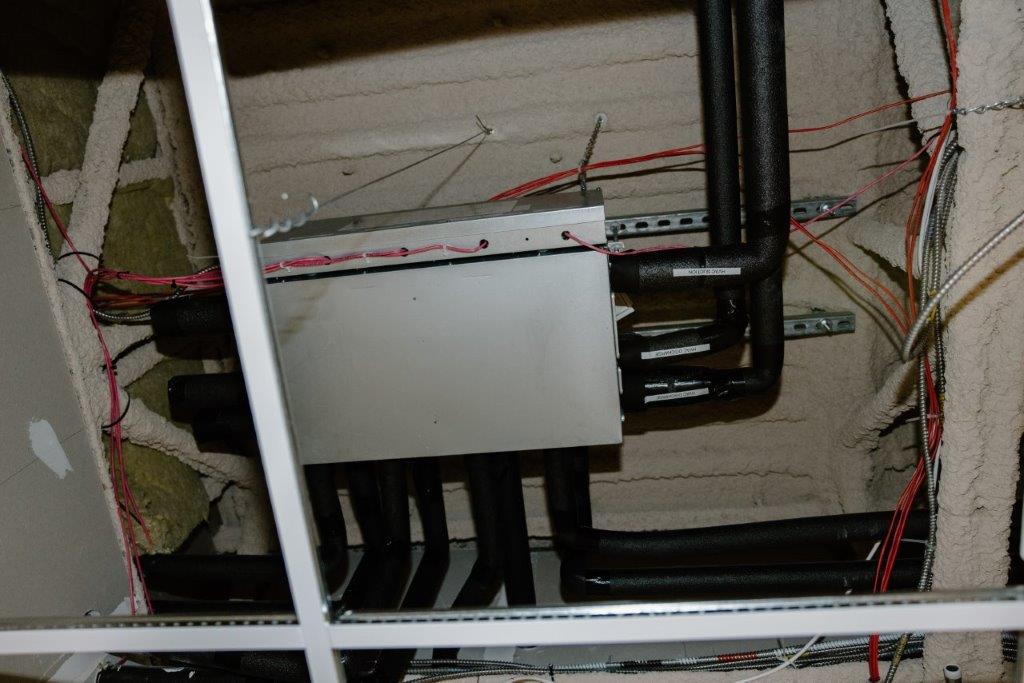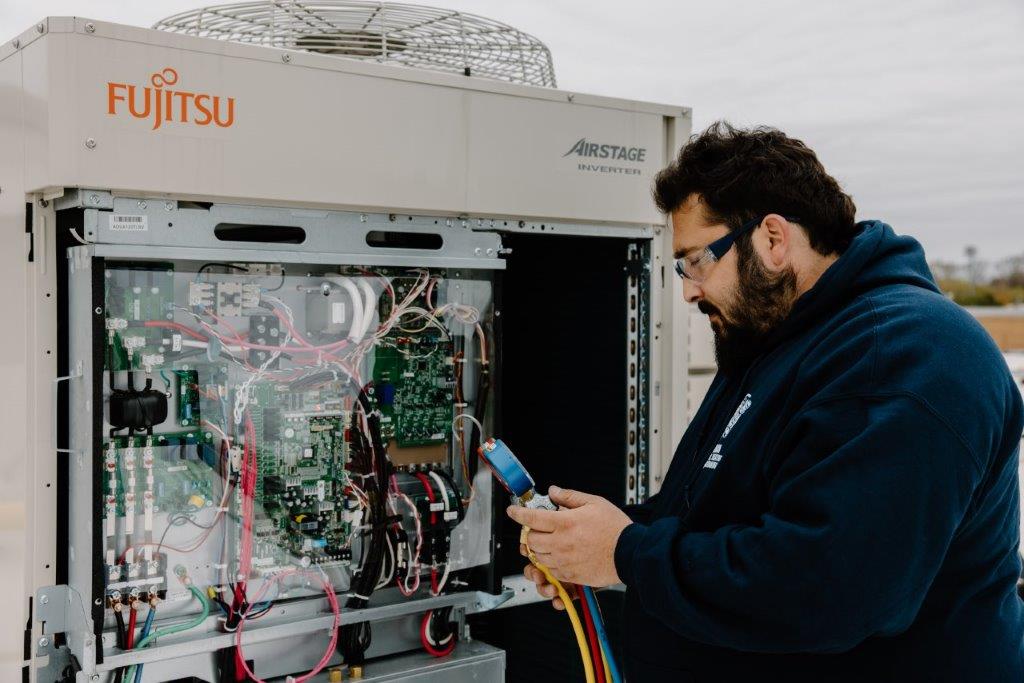Passaic County Technical Institute (PCTI) in Wayne, N.J., is more than just a tech school. Of course the trades are offered, but it’s also a high school, open to students from grades seven through 12 with courses covering everything from criminal justice and finance to automotive technology and culinary arts. It even has an athletics and music program.

The school has grown significantly in recent years, and the need to expand and repurpose its facilities became a priority as the country emerged from the pandemic.
Pattman Plumbing, Heating & Air Conditioning, based in Midland Park, N.J., received a plan and spec design for an office expansion from PCTI’s architect at the tail end of 2021. The school’s IT department needed more space, and the large second floor of a renovated building was soon to house a variety of new offices.
Pattman focuses exclusively on installation work for institutional and municipal clients. President Jack Pattman started in the mechanical trade in 1983 and began transitioning away from residential work about 15 years ago.
“Our first foray into institutional work began in the 1990s with science lab renovations,” said Pattman. “We’d approach a science project one lab at a time, and we got very good at it. Over the years, our network of district managers and general contractors grew. What started as lab renovations turned into almost anything mechanical that schools might need.”

When Pattman received the design for a variable refrigerant flow (VRF) system to heat and cool the space at PCTI, he determined that heat recovery might be feasible. Given the multiple offices and a large amount of exterior walls making up the space, heat recovery systems were considered and ultimately selected.
“We contacted Johnstone Supply’s Keith McGowan, commercial sales manager, and Chris Renna, commercial equipment design estimator, to help specify their Fujitsu Airstage line of VRF systems,” said Pattman. “We installed Airstage equipment on a similar job about two years ago—at Fort Lee High School—and Johnstone Supply was a great help on that project. The original VRF design at PCTI didn’t specify Fujitsu, but I knew that we could accomplish the same thing or better at a lower price point.”
Renna crossed the spec from another manufacturer and worked with Pattman to develop design simulator piping, wiring, and control drawings, and included addressing the equipment so Pattman had a clear plan to follow. Renna was also involved with the Fort Lee project and worked well with the team in the field, stopping at the jobsite to help with any technical questions.
Much like Pattman Plumbing, Heating & Air Conditioning, Johnstone deals extensively with institutional projects. Across its nine branches, we work with roughly 50 school districts, helping to identify and design the best solutions for their plumbing and HVAC needs, as well as training the maintenance staff that take over the systems after installation.
Heat Recovery
PCTI’s new office space, totaling 2,700 square feet, is comprised of two individual offices, a large, common workspace for numerous desks, and a considerable storage area. The most unique element of the space is certainly its “sky” theme.

With lots of window space, the open common area has blue walls and the ceiling features cloud-like, round areas of white grid drop ceiling, giving the occupant a feeling of being outside on a partially cloudy day. Above the suspended cloud clusters, the ceiling deck and all mechanical components attached to it are painted flat black.
The common work area is severed by a single VRF zone, served by four 14,000 BTUH Airstage ceiling cassettes. The two individual offices are served by 9,000 BTUH ceiling cassettes, while the storage room is heated and cooled via one more 14,000 BTUH cassette.
In all, there are four heating and cooling zones, and all zones are connected to a single refrigerant branch unit, meaning that loads across the system are shared from zone to zone before tapping the 10-ton Airstage VRF condenser on the roof for capacity.
The space is ideal for heat recovery technology. Facing south with an almost entirely glass façade, the sky room receives a great deal of solar gain, meaning that it will remain in cooling mode for the better part of three seasons. Meanwhile, the individual offices and storage areas have no windows or exterior walls. Heat recovery systems capitalize on the conflicting loads across all zones connected to the same refrigerant branch unit. BTUs rejected from one zone with a call for cooling are salvaged and provided to zones with a call for heat.
When there is a demand for both heating and cooling in a building, heat recovery can be one of the most-efficient heating and cooling options, saving significant energy over conventional systems. Not only are these systems able to provide simultaneous heating and cooling across a single system, but energy is saved in the process.

The Airstage V-Series line includes systems as small as the three-ton single-phase J-IV model and as large as 24 tons in the commercial three-phase line. While VRF systems in general are extremely flexible and applicable to almost any building type, heat recovery VRF systems specifically are ideally suited to applications where varying loads are present. When it makes sense, it makes a lot of sense. Heat recovery can save a great deal of energy while providing premium comfort.
Airstage heat recovery systems are available between six and 24 tons, which means that an engineer could design a system with as many as 63 zones sharing loads throughout a building. In a properly designed heat recovery VRF system, connected capacity of the indoor units may be sized to 150% of the total capacity of the outdoor units in the system. This is because loads are shared between zones instead of relying solely on the condensing unit.
The disparity between the loads at PCTI were ideal for heat recovery, but there was also an element of the architectural design that greatly benefited from the flexibility of a VRF system.
Installation Flexibility
The 11 drop ceiling “clouds” were suspended only a short distance from the ceiling deck to keep the ceiling as high as possible. Installing ductwork would have lowered the clouds and would have been harder to conceal than the linesets needed for the VRF system. The flexibility in lineset length available with the Airstage system simplified the only challenge that Pattman encountered on the project.
“We had to coordinate closely with the general contractor on placement of the HVAC components in the common area,” said Talib Najjar, general manager at Pattman. “They had to mark out where the floating clouds would hang, and we had to hit the drop ceiling grid perfectly in order to place our ceiling cassettes and avoid interfering with light fixtures.”

From there, it wasn’t difficult to conceal the refrigerant lines with other mechanical equipment on the ceiling deck, like fire suppression and electric. The system was commissioned on March 10, 2021.
Renna performed the certified commissioning process and submitted run data to Fujitsu to receive the full extended warranty. Because Renna has worked with Pattman before, the commissioning process went smoothly. Pattman had completed all pre-commissioning tests and was familiar with what was needed for a successful start-up and commissioning.
“The project wrapped up seamlessly, and the customer is delighted with the results,” said Pattman. “We worked through the usual plan discrepancies and changing site conditions, but there were no real challenges. The equipment went in just as expected, started up and ran perfectly.”
Training for Maintenance
Commissioning was only the halfway point of the project for Johnstone. We returned to PCTI in mid-May to train A&A Construction, the school’s property maintenance company. The main focus was service and maintenance of the VRF system and its connection to the BAS. Some of the IT staff who work in the offices also attended, so general operation was also covered.

We reviewed the controls, preventative maintenance, and some trouble-shooting techniques they may need in the future. The maintenance staff also download the Fujitsu Mobile Technician app for trouble-shooting, at which point we discussed basic thermostat operation.
A&A Construction liked the system and appreciated the support from Johnstone. They were impressed once they saw and understood Pattman’s installation.
VRF technology is growing across all segments of the HVAC market, but especially in educational applications. More often than not, when a project goes out to bid, the installing contractor only owns the project for a year. After that, a maintenance company like A&A takes over. It’s invaluable for the wholesaler to develop relationships with the maintenance professionals, educate them on the system, and remain available throughout the life of the system.
“We’re seeing more and more interest in VRF, especially where ceiling space is limited,” said Pattman. “It’s only going to become more popular with engineers, contractors, and architects. Forming relationships with everyone involved is more important than ever, and strengthens our commitment to growing through word of mouth. That approach has worked well for us for a long time, and it looks like it will continue to do so.”

Keith McGowan is Commercial Sales Manager for Johnstone Supply. He started his HVAC career in 1986, receiving his Black Seal Boiler License before completing a four-year HVAC course at Union County Technical School. He entered the commercial side as a sheet metal and pipe fitting specialist becoming a service technician and eventually service and project manager for a large Tri-State mechanical contracting firm. After 30-plus years in the field, he joined Johnstone Supply.
